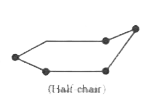Which of the following is the least stable?
Pb+2
Tl+
Al+3
B+1
The correct Answer is:D
To determine which of the given elements is the least stable, we need to analyze the oxidation states and their stability based on the inert pair effect. Here’s a step-by-step breakdown of the solution:
Step 1: Identify the Elements
First, we need to identify the elements in question. The elements mentioned are lead (Pb) and thallium (Tl), which belong to the carbon and boron groups respectively.
Step 2: Understand the Group Trends
- Lead (Pb): Lead is in Group 14 (carbon group) with a general electronic configuration of ns² np². It can exhibit oxidation states of +2 and +4. However, due to the inert pair effect, the +2 oxidation state becomes more stable as we move down the group.
- Thallium (Tl): Thallium is in Group 13 (boron group) with a general electronic configuration of ns² np¹. It can exhibit oxidation states of +1 and +3. Again, due to the inert pair effect, the +1 oxidation state becomes more stable as we move down the group.
Step 3: Analyze the Stability of Oxidation States
- For Lead (Pb): The +2 oxidation state is more stable than the +4 oxidation state due to the inert pair effect.
- For Thallium (Tl): The +1 oxidation state is more stable than the +3 oxidation state due to the inert pair effect.
Step 4: Compare the Stability
Now, we compare the stability of the least stable oxidation states:
- Lead has a less stable +4 oxidation state.
- Thallium has a less stable +3 oxidation state.
Step 5: Determine the Least Stable Element
Considering the trends:
- The +4 oxidation state of lead is relatively less stable compared to the +3 oxidation state of thallium.
- Therefore, thallium, with its +3 oxidation state, is less stable than lead in terms of its higher oxidation state.
Conclusion
Thus, among the elements discussed, Thallium (Tl) is the least stable due to the instability of its +3 oxidation state compared to lead's +4 oxidation state.
First, we need to identify the elements in question. The elements mentioned are lead (Pb) and thallium (Tl), which belong to the carbon and boron groups respectively.
- Lead (Pb): Lead is in Group 14 (carbon group) with a general electronic configuration of ns² np². It can exhibit oxidation states of +2 and +4. However, due to the inert pair effect, the +2 oxidation state becomes more stable as we move down the group.
- Thallium (Tl): Thallium is in Group 13 (boron group) with a general electronic configuration of ns² np¹. It can exhibit oxidation states of +1 and +3. Again, due to the inert pair effect, the +1 oxidation state becomes more stable as we move down the group.
- For Lead (Pb): The +2 oxidation state is more stable than the +4 oxidation state due to the inert pair effect.
- For Thallium (Tl): The +1 oxidation state is more stable than the +3 oxidation state due to the inert pair effect.
Now, we compare the stability of the least stable oxidation states:
- Lead has a less stable +4 oxidation state.
- Thallium has a less stable +3 oxidation state.
Considering the trends:
- The +4 oxidation state of lead is relatively less stable compared to the +3 oxidation state of thallium.
- Therefore, thallium, with its +3 oxidation state, is less stable than lead in terms of its higher oxidation state.
Thus, among the elements discussed, Thallium (Tl) is the least stable due to the instability of its +3 oxidation state compared to lead's +4 oxidation state.
Topper's Solved these Questions
- BOOK - VMC MODULES ENGLISHCHAPTER - PERIODIC PROPERTIES OF ELEMENTSEXERCISE - EFFICIENT50videos
PERIODIC PROPERTIES OF ELEMENTS
- BOOK - VMC MODULES ENGLISHCHAPTER - PERIODIC PROPERTIES OF ELEMENTSEXERCISE - IMPECCABLE50videos
PERIODIC PROPERTIES OF ELEMENTS
- BOOK - VMC MODULES ENGLISHCHAPTER - PERIODIC PROPERTIES OF ELEMENTSEXERCISE - IMPECCABLE50videos
PERIODIC PROPERTIES OF ELEMENTS
- BOOK - VMC MODULES ENGLISHCHAPTER - p-BLOCK ELEMENTS-1EXERCISE - JEE Advanced Archive48videos
p-BLOCK ELEMENTS-1
- BOOK - VMC MODULES ENGLISHCHAPTER - QUIZEXERCISE - CHEMISTRY30videos
QUIZ
Similar Questions
Knowledge Check
- Question 1 - Select One
Whịch of the following is the least stable conformer of cyclohexane ?
A B
B C
C D
D
Which of the following is the most stable species ?
View SolutionWhich of the following is the most stable cycloalkane ?
View SolutionWhich of the following is the most stable carbocation?
View SolutionWhich of the following is least stable ?
View SolutionWhich of the following is least stable?
View SolutionWhich of the following is least stable ?
View SolutionWhich of the following is least stable ?
View Solution
